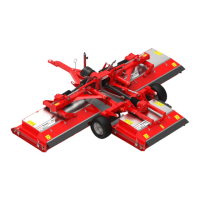TRIMAX SNAKE S2 OPERATORS MANUAL
ENGLISH EDITION
©Trimax Mowing Systems (NZ) Ltd
www.trimaxmowers.com 9 27 March 2019
Hydraulic systems such as hydraulic drives
or lift rams & the tractor’s auxiliary hydraulic
system are operated by fluid under
enormous pressure. Leaks can result in fine
high-pressure jets that can penetrate soft
tissue with ease. Hydraulic oil is also toxic to
the body & must be surgically removed to
prevent gangrene.
Never use hands or fingers to
inspect hydraulic hoses. Hold a
piece of paper, cardboard or wood
as a target when inspecting for
hydraulic leaks.
The application of grease to bearings and
moving parts on the mower could result in
grease getting in eyes or into cuts on hands.
Free-wheeling
parts hazard
Heavy revolving parts continue to rotate
after the power is shut off. Flail & rotary
mower blades, pulleys & driveshafts may
keep turning for several seconds after the
drive is disengaged. Injury can occur when
operators attempt to work on the machine
before all moving parts have stopped.
Wait for all moving parts to stop
before approaching the machine.
Slips, trips &
falls hazard
Slips & falls can result from slippery
surfaces or cluttered work areas. Mowers
parked after operating can leak large
puddles of water onto the ground. Care is
required when moving around them.
Take care when moving around the
mower.
Practice good housekeeping. Keep
floors clean & dry.
Put away anything not required for
the job.
Wear shoes with slip-resistant
soles.
3b. Safety Labels.
1. General:
a. Always keep safety labels and signs clean and legible always.
b. Replace safety labels and signs that are missing or have become difficult to read.
c. Any parts that are replaced must also show the same safety decals as before if removed.
d. Safety labels are available from your dealer parts department or from Trimax Mowing Systems.
They come in a single sheet which contains all the labels used on the machine.
2. How to install Safety Labels:
a. Use scissors to cut out the label required. Leave some material outside the cut line around the
label.
b. Be sure the installation area is clean and dry.
c. Decide on the exact location before removing backing paper.
d. Peel back the backing paper and fold it back to expose a small area of the sticky backing.
e. Position the label as required and press the area with the exposed sticky backing onto the
required surface.
f. Slowly peel the backing paper from the rear while evenly pressing the label onto the surface.

